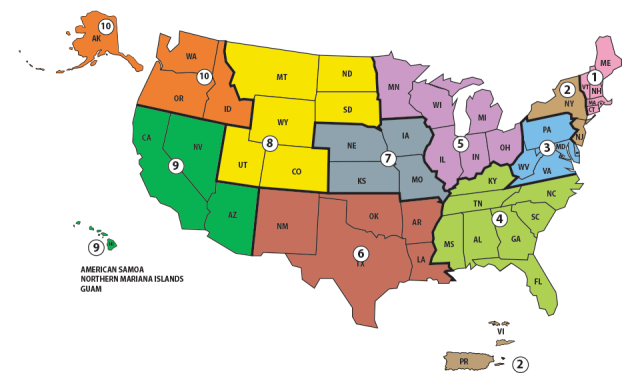EPA Regions
EPA has 10 regional offices that are each responsible for managing the TRI Program across multiple states. Some regional offices are also responsible for territories and tribes.

The type and number of facilities vary within each EPA region. As a result, there are significant differences in TRI chemical waste management practices and quantities across the regions, as shown in the figure below.
- Facilities in Region 10 reported more releases for 2023 than those in any other region, totaling 979 million pounds. Release quantities were driven by one metal mine in Alaska.
- In Regions 8, 9, and 10, the metal mining sector accounted for more releases than any other sector.
- Metal mines tend to report high releases because the extraction and processing of metal bearing rock (called ore) results in large quantities of waste containing TRI-reportable metals. This waste is typically disposed of on site to land.
- Metal mines manage very little of their waste through treatment, combustion for energy recovery, or recycling. As a result, regions with significant metal mining operations tend to have higher releases but lower treatment, recycling, and energy recovery quantities than other regions.
- Waste managed in Region 7 was driven by recycling and treatment by chemical manufacturing facilities.
- In Region 6, the chemical manufacturing sector accounted for more than 70% of waste managed.
- Facilities in Region 5 reported more waste managed than those in any other region, driven by facilities in the food manufacturing sector.
- Waste managed in Regions 3, 4, and 5 was driven by recycling in the chemical and food manufacturing sectors. These regions all have one or more facilities reporting high quantities (i.e., more than a billion pounds) of chemicals recycled on site for 2023.
- Regions 4 and 5 had the most facilities reporting for 2023 with 4,735 and 5,257 facilities, respectively. Combined, almost half of all facilities that reported to TRI are in these two regions.
- Regions 1 and 2 had the lowest releases and total waste managed. Nationally, most releases and waste managed are reported by facilities in the metal mining, chemical manufacturing, primary metals manufacturing, natural gas processing, electric utilities, or food manufacturing sectors. Relatively few facilities in these sectors operate in Regions 1 and 2, leading to lower release and waste management quantities in these two regions.
This page was published in August 2025 and uses the 2023 TRI National Analysis dataset made public in TRI Explorer in October 2024.
